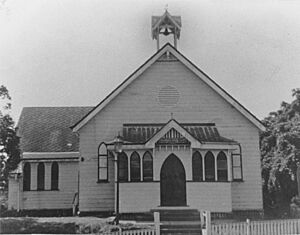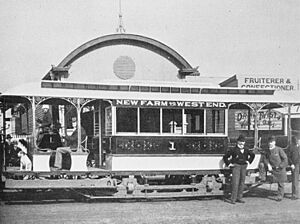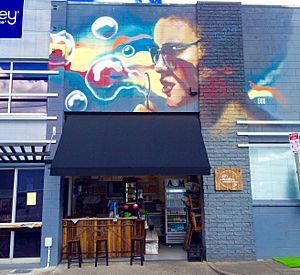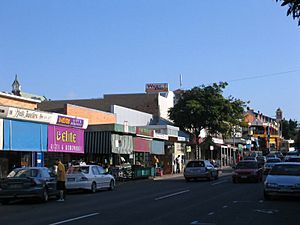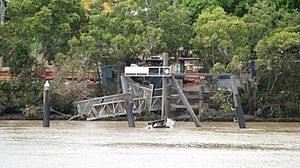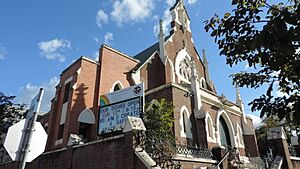West End, Queensland facts for kids
Quick facts for kids West EndBrisbane, Queensland |
|||||||||||||||
|---|---|---|---|---|---|---|---|---|---|---|---|---|---|---|---|
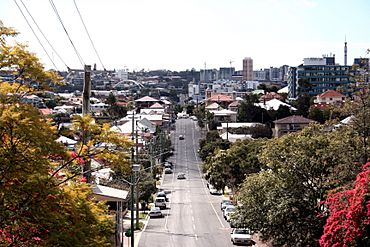
View down Boundary Street
|
|||||||||||||||
| Population | 14,730 (2021 census) | ||||||||||||||
| • Density | 6,400/km2 (17,000/sq mi) | ||||||||||||||
| Established | 1860s | ||||||||||||||
| Postcode(s) | 4101 | ||||||||||||||
| Area | 2.3 km2 (0.9 sq mi) | ||||||||||||||
| Time zone | AEST (UTC+10:00) | ||||||||||||||
| Location | 2.9 km (2 mi) SW of Brisbane CBD | ||||||||||||||
| LGA(s) | City of Brisbane (The Gabba Ward) | ||||||||||||||
| State electorate(s) | South Brisbane | ||||||||||||||
| Federal Division(s) | Griffith | ||||||||||||||
|
|||||||||||||||
West End is a lively suburb located just south of the city center in Brisbane, Queensland, Australia. It's known for its unique mix of cultures and busy streets. In 2021, about 14,730 people called West End home.
The local Aboriginal people call this area Kurilpa. This name means place of the water rat.
Contents
- Exploring West End's Location
- West End's Past: A Journey Through Time
- West End's People: A Diverse Community
- Places of History: Heritage Listings
- West End Today: Planning and Growth
- West End's Economy: Food, Shops, and More
- Learning in West End: Schools
- Getting Around West End: Transport
- West End's Culture: Art and Community
- Community Places: Amenities
- Sports and Recreation in West End
- Green Spaces: Parks in West End
- Images for kids
Exploring West End's Location
West End is surrounded by the Brisbane River on its western and southern sides. This makes it feel like a special place, almost like an island!
Hill End: A Neighborhood Within West End
Hill End is a smaller area inside West End. It's located in the southwest, very close to the Brisbane River.
West End's Neighbors
West End sits next to the suburbs of South Brisbane and Highgate Hill. Together, these three suburbs form a land shape that sticks out into the Brisbane River.
West End's Past: A Journey Through Time
Before European settlers arrived, the West End area was an important meeting place for Aboriginal people. There was a large camp near what is now Musgrave Park. Boundary Street, a well-known street in West End, got its name because it used to mark the edge of the original town of Brisbane.
The Rainforest and Its Creatures
The riverbanks of West End were once covered in thick rainforest. It was a beautiful, wild place filled with many different plants and animals. One important animal was the bush rat, or fawn-footed melomys. These rats were a big part of the local Aboriginal diet and stories. The Aboriginal name Kurilpa comes from Kureel-pa, meaning place of water rats. This name is still used today for many places in the area.
How West End Got Its Name
Early British settlers named the area "West End" because it reminded them of the West End of London, a famous part of that city.
Early Farms and Water Sources
The soil in West End was very good for farming. Early European settlers grew crops like strawberries. People could even pay a small fee to eat as many strawberries as they wanted! There was also a creek and a spring that provided water for the residents, especially during dry times.
Schools and Churches Beginnings
In the 1870s, the first churches and schools started to appear. A Primitive Methodist Church opened in Hill End in 1873. In 1875, three schools opened: West End Boys State School, West End Girls State School, and West End Infants State School. These schools later joined together to form the West End State School we know today. The land for the school was originally meant to be a cemetery, but it was never used for burials.
In 1879, the Brighton Road Congregational Church was finished. It was a beautiful church made of wood with a Gothic-style roof. This church is no longer there, but a retirement village now stands on its site.
Growing Industry and Transport
The 1880s saw more factories and businesses set up along Montague Road. West End became a popular place to live because it was close to the city, had nice river breezes, and public transport was getting better.
The West End Wesleyan Methodist Church opened in 1884. It was a large brick church that could seat many people. Today, it is known as the West End Uniting Church and is a heritage-listed building.
West End was one of the first suburbs in Brisbane to have a tram line, starting in 1885. At first, horses pulled the trams, but later they became electric. The tram line helped people travel around the area until it closed in 1969.
St Peter's Anglican Church was built in 1888. It was made of Oregon pine and could seat 175 people. Today, this old church building is used as a childcare center.
Floods and New Buildings
The riverside parts of West End were badly flooded in 1893. The West End Library opened in 1925, giving residents a place to read and learn.
St Francis of Assisi Catholic Church was built in 1923. A few years later, it was moved to a larger site across the street. In 1928, St Francis' Catholic Primary School opened next to the church. The school was run by the Sisters of Mercy.
The old Tristram's Drink Factory, built in 1928, is a famous landmark in West End. It has a unique design and was turned into a market in the 1990s.
The Dornoch Terrace Bridge was completed in 1941. It replaced an older bridge and was meant to lead to a new bridge across the Brisbane River to the University of Queensland. That bigger bridge was never built, but people still talk about building one today.
Changes in Schools and Flooding Again
Christian Outreach College opened in West End in 1978 but later moved to a different suburb. The Brisbane School of Distance Education, which helped students learn from home, was also in West End for many years before moving in 2011.
West End was affected by the big 2010–2011 Queensland floods. Many low-lying areas had to be evacuated.
West End's People: A Diverse Community
West End is known for its diverse population. In 2021, there were 14,730 people living here. Many different cultures and backgrounds make up the community.
Historically, West End has been home to a large Greek Australian community. People from many other countries also live here, making it one of Brisbane's most successful multicultural areas. Most people speak English at home, but you'll also hear Greek, Vietnamese, Mandarin, and other languages.
Places of History: Heritage Listings

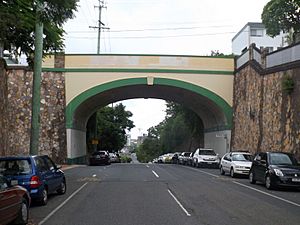
West End has many buildings and places that are listed for their historical importance. These "heritage-listed" sites help preserve the suburb's unique character. Some examples include:
West End Today: Planning and Growth
West End has a mix of old houses and new apartment buildings. Many historic homes are protected to keep their original look. However, new, modern buildings are also being built, changing the suburb's skyline.
Property prices in West End have been going up a lot. There are plans to allow taller buildings in some areas, especially near the river. This means more people can live in West End, but it also changes the feel of the area.
West End's Economy: Food, Shops, and More
West End is famous for its many cafes and restaurants, especially along Boundary Street. It's also a great place to find unique shops and organic grocery stores.
Every Saturday, Davies Park hosts the Green Flea Markets, a large farmer's market where you can find fresh produce and other interesting things. Many people enjoy weekend "brunch" at the cafes here.
Some older factories along Montague Road are being replaced by new apartments. This is part of a plan to bring more people to suburbs close to the city.
Learning in West End: Schools
West End State School is a primary school for children from Prep to Year 6. It's located on Vulture Street. The school is growing, and there are plans to expand its site.
There isn't a high school directly in West End. The closest government high school is Brisbane State High School in nearby South Brisbane. This school is very popular and known for its strong academics. Many families want to live in West End to be in the catchment area for this school.
Getting Around West End: Transport
West End has good public transport options, including buses and ferries. Buses run frequently, connecting West End to the city and other areas. There's even a free bus loop called the Kurilpa Bus Loop that helps people get around South Brisbane and West End.
You can also catch a CityCat ferry from the West End ferry wharf on Orleigh Street. The ferry terminal was damaged in the 2011 floods but was quickly rebuilt and reopened.
West End's Culture: Art and Community
West End is a hub for artists. You'll find many art galleries and places where local artists show their work. While Brisbane's main cultural area is in South Brisbane, many artists and students choose to live in West End because it's a larger, more residential suburb.
Community Places: Amenities
The Brisbane City Council runs a public library in West End, located on Boundary Street. It's a great place to borrow books and use computers.
St Francis of Assisi Catholic Church and West End Uniting Church are important places of worship in the community.
Sports and Recreation in West End
West End is home to the Souths Logan Magpies rugby league team. They play their home games at Davies Park. Many famous rugby league players have played for the Magpies over the years.
Along the Brisbane River, you'll find rowing sheds used by local schools and rowing clubs. The Commercial Rowing Club, established in 1877, is Queensland's oldest amateur sporting club.
The South Brisbane Sailing Club is also located in West End, near Orleigh Park. It has been a part of the community since 1903.
Green Spaces: Parks in West End
West End has many lovely parks where people can relax and play. Some of these include:
- Boundary Street Park
- Bunyapa Park (formerly West End Urban Common)
- Davies Park
- Orleigh Park
- Ryan Street Parks
- South Brisbane Riverside Lands Park
- West End Community Park
- West End Riverside Lands Park
Bunyapa Park was renamed in 2017. Its new name was suggested by Aboriginal activist Sam Watson.
Images for kids
-
The Kurilpa Library on Boundary Street
-
The Dornoch Terrace Bridge over Boundary Street



